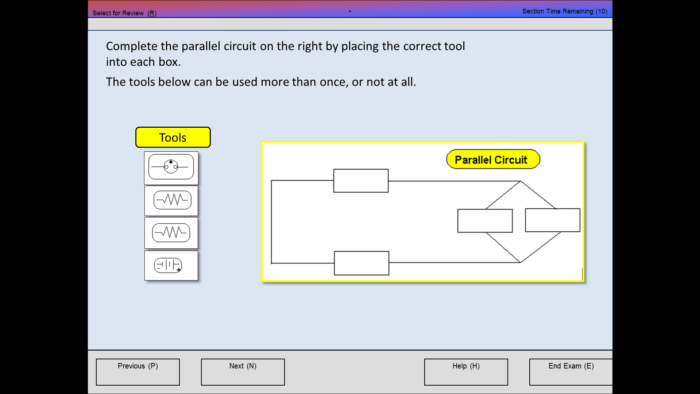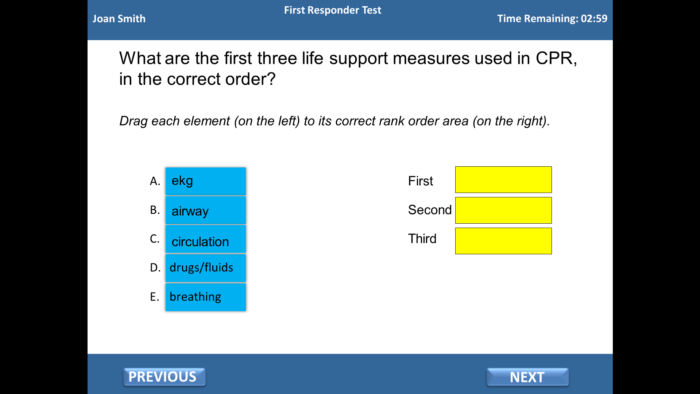From the Item Bank |
||
The Professional Testing Blog |
||
The Drag and Drop – Why, When, and How to Use this Item TypeJune 22, 2016 | |OverviewThe Drag and Drop (DD) item typically includes a list of elements that the examinee is asked to associate with a second list of elements, by dragging and dropping one element at a time. The DD item type has a substantive value that many exam programs appreciate, due to the candidate’s cognitive thinking that can be tapped. When to UseThere are several distinct construct-relevant uses of the DD item type. Items can be written to test association (matching), sequencing, and prioritizing. Any of these purposes may be relevant to the construct of a specific exam. And these construct purposes can be targeted using text in both list, text in one and images in the second, or two lists of images. Additionally, one list of elements can be displayed along with a single larger image on which the candidate places each drag-element. In one approach, DD items can be used for matching elements in two separate lists, as this example illustrates. Other matching instances of the DD could use two lists of text (e.g., names of U.S. states and capital cities in a social studies exam), or one list of illustrations and a second list of their text names (perhaps for a language test). Note: Parshall, C.G., & Cadle, A. (2015, March). How to identify, develop, and implement innovative items. Presented at the Association of Test Publishers meeting, Palm Springs, CA. In another variation on the matching type of DD item, examinees may be asked to match an element to its “location” within a larger structure, such as the parallel circuit example below. Other examples of this DD variation could include an organizational chart, blueprint, or site plan.
Note: Adapted from Harmes, J.C., & Parshall, C.G. (2009, February). Innovative Items: A Six-Step Process for Design, Development, & Implementation. Presented at the Association of Test Publishers meeting, Palm Springs, CA. Other DD items target cognitive tasks related to sequencing or prioritizing. In these items, a single list of drag-elements is displayed and the examinee is asked to drag some or all of these elements into a specified order. (This sub-type of the DD is sometimes referred to as ordered response.) In the example below examines are prompted to drag the first three steps into their correct sequence.
Note: Adapted from Parshall, C.G., Depascale, C., & Skinner, L. (2011, February). Adapting Parshall and Harmes Six-Step Model to the Integration of Alternative Item Types into a Multiple Choice Testing Program. Presented at the Association of Test Publishers meeting, Phoenix, AZ. In a slightly different cognitive task, examinees might be asked to order elements in terms of their prioritized importance, rather than their sequence. Issues to ConsiderThe DD item type is provided within several CBT delivery applications. The specific options as to how the DD item may be implemented, such as the maximum number of options and scoring models available, are likely to differ across CBT programs. In some applications, partial credit or weighting of the DD item may be available. However, many exams implement DD items that are scored dichotomously and are given the same weight as the exam’s MC items. One issue for the testing organization to consider is whether to define an item writing guideline for the DD that limits the number of options that should be included in a single item. The DD item type is potentially complex, with many moving parts, and a lengthy DD item can require too much candidate knowledge or time, if the item is only “worth” a single score point. Alternatively, a decision could be made to weight D&D items more heavily, or to use some type of partial credit scoring. Another issue to consider for the DD is the need to avoid cuing within the item. To accomplish this, it can be helpful avoid a 1-to-1 match between lists. For example, the “to be dragged” list can include more elements than in the list of target locations. Alternatively, the item can be written such that drag-elements can be appropriately placed in more than a single target location. Both of these techniques will reduce any inherent cuing in the item type. SummaryThe DD item type has potential value for measuring construct relevant skills within the exam program. Furthermore, it can often be used by candidates more easily that alternative item formats (e.g., type k items, sorting) for the same content. For many exams, the DD is an item type worth including. This post is part of the series “Alternative Item Types.” Tags: Alternative Item Types, ATP 2018, ATP17, Item TypeCategorized in: Industry News, Item Type |
||





Comments are closed here.